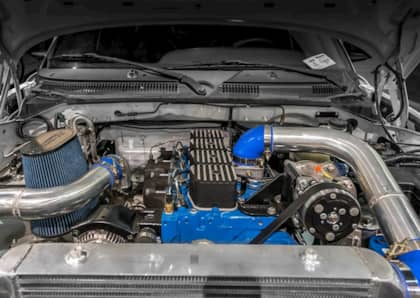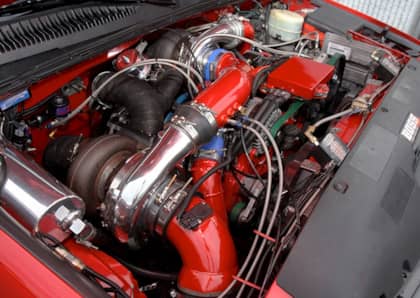11 Reasons Why Diesel Trumps Gasoline
Occasionally, we like to stir the automotive pot, and this one is sure to do it! It’s the age-old diesel vs. gas debate—and it’s guaranteed to get a few of you into a verbal throw down. While both forms of propulsion have their place, diesel tends to dominate when big jobs have to be tackled as efficiently and reliably as possible (hence its preferential use in the military, construction, transportation and railroad industries). On the racing scene, gasoline engines have long held the throne in most categories.
However, in recent years, diesel technology has advanced at a rapid pace, which has only promoted further versatility—namely in 3/4-ton and 1-ton trucks. No longer are these oil-burners limited to workday chores. It’s now common to spot an 8,000lb, diesel-powered Ford, GM or Ram tearing through the quarter-mile in 13, 12, 11 and even 10-second intervals. Diesels have also begun to draw large crowds at chassis dyno competitions and headline the biggest sled pulls in the country. Once upon a time, the Audi R10 TDI even infiltrated (and dominated) the esteemed Le Mans racing series.
So, with diesel excelling in so many key areas, is it the better engine choice? Judging by the title, it’s pretty clear which side yours truly plays for, but whose side are you on? Diesel or Gas?
1. High Compression = More Power & Better Efficiency
What do OEM manufacturers, aftermarket enthusiasts and all-out race teams do to increase power and efficiency in their gas engines? They up compression. Diesels range from roughly 16.5:1 to 19:1 vs. gasoline’s typical 9:1 to 10:1. This means higher cylinder pressures (hello torque), a cleaner in-cylinder burn and—being that diesels rely on compression ignition rather than spark—no worry of pre-ignition or detonation.
2. No Throttle Plate

Unlike a gasoline engine, a diesel doesn’t have a throttle plate (which should more appropriately be labeled a “restriction plate”). This means a diesel’s cylinders are packed completely full of air during every intake stroke, regardless of the driving or operating conditions. By contrast, the only time a gas engine breathes this well occurs under wide-open throttle instances. A lack of throttle (restriction) plate also means no pumping losses for the diesel engine. Did you know a gas engine expends as much as 40-percent of its total power output trying to overcome its own air (throttle) restriction?
3. Any-Purpose Engine

No other internal combustion engine is as versatile as a diesel. For instance, only a diesel-powered pickup can be used as an all-in-one work truck, tow rig, sled puller, drag racer and daily commuter and remain as reliable as it was the day it left the factory. There are thousands upon thousands of diesel trucks making 500hp (1,000 lb-ft) or more that serve all of the above functions, not to mention that four-wheel drive models offer year-round drivability and off-road capability. The allure of a diesel engine is its do-anything nature.
4. Better Ingredients

Because diesels feature high compression ratios, see high cylinder pressures and are typically turbocharged—they’re built with burlier parts to withstand all the stress. This means premium items like forged-steel connecting rods, four-bolt mains, six head bolts per cylinder, compacted graphite iron blocks... even bed plates make it into a lot of diesel engines. As well, nearly all heavy-duty diesel engines are gear-driven (no timing chains or belts).
5. Leaner Air-Fuel Ratio

When you run a gasoline engine too lean you kill its power potential, run the risk of overheating or worse, melting a piston. In an effort to cool down combustion, gas engines will dump extra fuel at wide-open throttle. The complete opposite is true of a diesel. Lean out the fuel and the engine runs cooler. Add fuel to the mix and combustion temps and exhaust gas temperature goes up. This is why diesels run a leaner air-fuel ratio than gas engines. In fact, some diesels utilize an air-fuel ratio as high as 90:1 or 100:1 at idle. Optimum gasoline air-fuel mixtures usually check in around 15:1, while most diesels operate at 18:1 or higher.
6. Better, Safer Fuel

Diesel fuel’s chemical makeup makes it at least 15-percent more energy dense than gasoline. On top of that, diesel fuel is oil-based, which essentially makes it a lubricant when introduced to cylinder walls. By contrast, gasoline is a solvent. Gasoline is also much more volatile than diesel (i.e. more explosive/flammable), which makes diesel much safer in the event of an accident.
7. They Aren’t Picky Eaters

Being that diesel is an oil-based fuel, it shouldn’t come as a surprise that virtually any oil-based alternative can be burned. We’ve seen diesel engines running on vegetable oil, grease, used engine oil and even automatic transmission fluid. But the diesel engine has always been capable of operating on alternative fuel sources. Case in point, the original diesel engine was designed to run on coal dust, but Rudolf Diesel subsequently found that it would also run (much more safely) on peanut oil.
8. Most Powerful

The most powerful engine in the world is diesel. Measuring approximately 90-feet long, 44-feet high and weighing some 2,300 tons, the Wartsila-Sulzer RTA96-C cranks out 109,000hp. The Finnish-designed, 14-cylinder, low-speed two-stroke diesel behemoth spins a maximum of 102 rpm, but generates as much as 80,080 KW of power—enough to power a moderately sized suburban town. Fitting for the world’s largest engine, the Wartsila-Sulzer RTA96-C is used to propel the largest ocean-going vessels in the world, such as 1,300-foot long, 70,000-ton cargo ships.
9. Big Torque at Low RPM
Thanks in part to the extreme cylinder pressures they see, most diesel engine’s produce their peak torque figure at or below 2,000 rpm. This not only makes diesel the ideal means of getting heavy loads up and moving quickly, but makes it easier for them to maintain speed while out on the highway. An abundance of low-rpm torque is also why 8,000lb diesel trucks can cut 1.5 to 1.8-second 60-foot times at the drag strip. While most gas power plants are just beginning to come to life between 3,000 and 4,000 rpm, a diesel is ready for the next gear. Living life at a lower rpm also lends itself to a diesel engine’s long-term durability.
10. A Mechanical Diesel is the Ultimate Doomsday Engine

Older, mechanically injected diesel engines are stupid simple and require virtually zero electronics to run. Once started, all a fully mechanical diesel needs to stay running is a steady supply of fuel. There is no need to worry about air, as once you fuel the engine the air will follow. If things ever go dark, you’ll find us driving something with a 12-valve 5.9L Cummins under the hood.
11. Diesel Makes the World Go Round

Frankly, if diesel isn’t superior to gasoline, why do the construction, trucking, shipping, railroad, aviation and mining industries rely on it almost exclusively? And why does every branch of the military depend on it? It’s because diesel is more efficient, powerful, reliable and versatile. With the power of diesel, you can travel farther, get more work done and even use an alternative fuel source if you have to.











